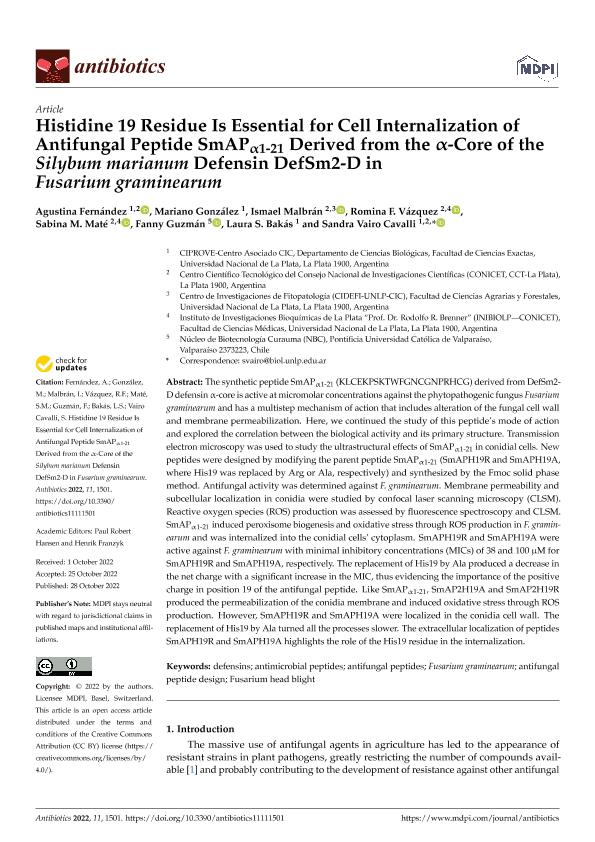Artículo
Histidine 19 residue is essential for cell internalization of antifungal peptide SmAPα1-21 derived from the α-Core of the Silybum marianum defensin DefSm2-D in Fusarium graminearum
Fernández, Agustina ; González, Mariano; Malbrán, Ismael
; González, Mariano; Malbrán, Ismael ; Vazquez, Romina Florencia
; Vazquez, Romina Florencia ; Maté, Sabina María
; Maté, Sabina María ; Guzmán, Fanny; Bakas, Laura Susana; Vairo Cavalli, Sandra Elizabeth
; Guzmán, Fanny; Bakas, Laura Susana; Vairo Cavalli, Sandra Elizabeth
 ; González, Mariano; Malbrán, Ismael
; González, Mariano; Malbrán, Ismael ; Vazquez, Romina Florencia
; Vazquez, Romina Florencia ; Maté, Sabina María
; Maté, Sabina María ; Guzmán, Fanny; Bakas, Laura Susana; Vairo Cavalli, Sandra Elizabeth
; Guzmán, Fanny; Bakas, Laura Susana; Vairo Cavalli, Sandra Elizabeth
Fecha de publicación:
10/2022
Editorial:
MDPI
Revista:
Antibiotics
ISSN:
2079-6382
Idioma:
Inglés
Tipo de recurso:
Artículo publicado
Clasificación temática:
Resumen
The synthetic peptide SmAPα1-21 (KLCEKPSKTWFGNCGNPRHCG) derived from DefSm2-D defensin α-core is active at micromolar concentrations against the phytopathogenic fungus Fusarium graminearum and has a multistep mechanism of action that includes alteration of the fungal cell wall and membrane permeabilization. Here, we continued the study of this peptide’s mode of action and explored the correlation between the biological activity and its primary structure. Transmission electron microscopy was used to study the ultrastructural effects of SmAPα1-21 in conidial cells. New peptides were designed by modifying the parent peptide SmAPα1-21 (SmAPH19R and SmAPH19A, where His19 was replaced by Arg or Ala, respectively) and synthesized by the Fmoc solid phase method. Antifungal activity was determined against F. graminearum. Membrane permeability and subcellular localization in conidia were studied by confocal laser scanning microscopy (CLSM). Reactive oxygen species (ROS) production was assessed by fluorescence spectroscopy and CLSM. SmAPα1-21 induced peroxisome biogenesis and oxidative stress through ROS production in F. graminearum and was internalized into the conidial cells’ cytoplasm. SmAPH19R and SmAPH19A were active against F. graminearum with minimal inhibitory concentrations (MICs) of 38 and 100 µM for SmAPH19R and SmAPH19A, respectively. The replacement of His19 by Ala produced a decrease in the net charge with a significant increase in the MIC, thus evidencing the importance of the positive charge in position 19 of the antifungal peptide. Like SmAPα1-21, SmAP2H19A and SmAP2H19R produced the permeabilization of the conidia membrane and induced oxidative stress through ROS production. However, SmAPH19R and SmAPH19A were localized in the conidia cell wall. The replacement of His19 by Ala turned all the processes slower. The extracellular localization of peptides SmAPH19R and SmAPH19A highlights the role of the His19 residue in the internalization.
Archivos asociados
Licencia
Identificadores
Colecciones
Articulos(CCT - LA PLATA)
Articulos de CTRO.CIENTIFICO TECNOL.CONICET - LA PLATA
Articulos de CTRO.CIENTIFICO TECNOL.CONICET - LA PLATA
Articulos(CIFICEN)
Articulos de CENTRO DE INV. EN FISICA E INGENIERIA DEL CENTRO DE LA PCIA. DE BS. AS.
Articulos de CENTRO DE INV. EN FISICA E INGENIERIA DEL CENTRO DE LA PCIA. DE BS. AS.
Articulos(INIBIOLP)
Articulos de INST.DE INVEST.BIOQUIMICAS DE LA PLATA
Articulos de INST.DE INVEST.BIOQUIMICAS DE LA PLATA
Citación
Fernández, Agustina; González, Mariano; Malbrán, Ismael; Vazquez, Romina Florencia; Maté, Sabina María; et al.; Histidine 19 residue is essential for cell internalization of antifungal peptide SmAPα1-21 derived from the α-Core of the Silybum marianum defensin DefSm2-D in Fusarium graminearum; MDPI; Antibiotics; 11; 11; 10-2022; 1-20
Compartir
Altmétricas



